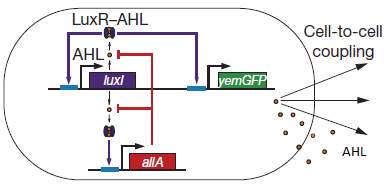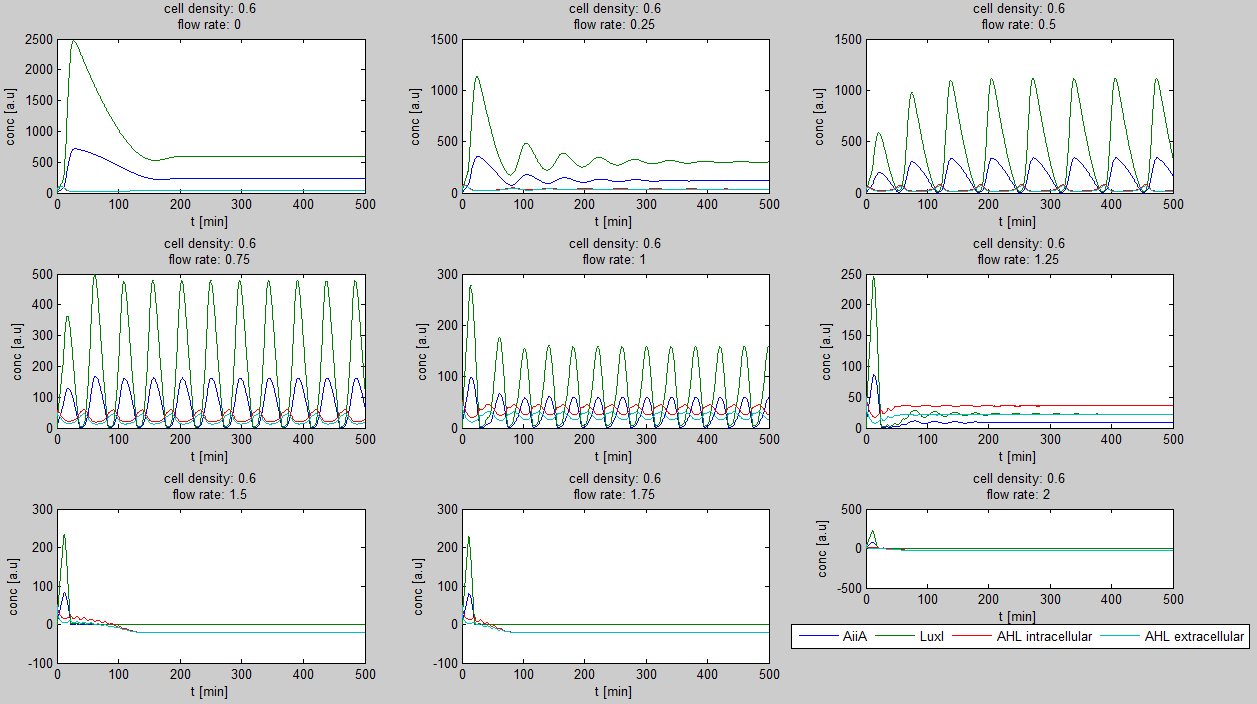Team:Wageningen UR/Project/ModelingProj1
From 2011.igem.org
Modeling synchronized oscillations
Short repetition of the Hasty construct used as base for our system
For a better understanding of the equations which were used for the modeling of the system, figure 1 shows a short repetition of the circuit published by Danino et al. in the paper [http://www.nature.com/nature/journal/v463/n7279/abs/nature08753.html “A synchronized quorum of genetic clocks”], in our team commonly referred to as the "Hasty construct", which was used as a base for our design.
Fig.1: Basic oscillating genetic circuit as published by Danino & Hasty.
The genes luxI and aiiA can be expressed when a AHL-LuxR complex binds to the promoter region. The circuit uses both a positive and negative feedback loop to control the AHL concentration and therefore the expression of the resulting proteins LuxI and AiiA. In the positive loop, LuxI generates more AHL, which, together with LuxR, can form more of the activating AHL-LuxR complex and therefore stimulates even more production of LuxI and consequently AHL. This complex also activates the expression of aiiA. In the negative feedback loop, AiiA degrades the AHL produced. For more detailed information about the circuit read more about the mechanism in the complete project description.
Mathematical model of the construct
Since our bio bricked oscillatory system is based on the design seen above, our first model of the system is a reproduction of the mathematical model in the [http://www.nature.com/nature/journal/v463/n7279/suppinfo/nature08753.html supplementary information] accompanying the publication mentioned. In their simulations, Danino et al. used the following set of delay differential equations, which we also used for our modeling tool written in matlab.
Above: Set of delay differential equations derived by Danino et al. to model the oscillatory behaviour of the design using a positive and negative feedback loop.
| A | : | AiiA |
| I | : | LuxI |
| Hi | : | internal AHL |
| He | : | external AHL |
The production of AiiA and LuxI depend on the internal AHL concentration in the single cell. The steps (transcription, translation, maturation etc.) from the luxI and aiiA genes to the corresponding proteins are not modeled separately, but the delay of the correlation between the internal AHL concentration and the corresponding AiiA and LuxI is simulated by the following Hill function:
in which tau represents the time step. It can be seen that the function takes the history of the system into account, since the production of the proteins depend on the past concentration of internal AHL as in: ![]() .
.
For the first simulations, the same values for the parameters were used as in the cited paper and can be found in the [http://www.nature.com/nature/journal/v463/n7279/suppinfo/nature08753.html supplementary information]. To get graphs representing optimal oscillations, the matlab tool allows the flow rate and cell density to be varied over a range of values. Figure 2 shows the GUI of the matlab tool created for this purpose.
It allows the user to enter the range in which the variables should be varied. The tool then iterates over the values and produces graphs of all combinations possible for that range of values. Figure 3 shows an example output of the tool.
The first observation from the model was that the flow rate necessary to obtain oscillations has to be very slow. Since the device used for our system has larger dimensions as the microfluidic device used by Danino et al. the flow rates in the velocities required couldn't be achieved by varying height differences alone. Further information can be found in the information about the devices.
 "
"




